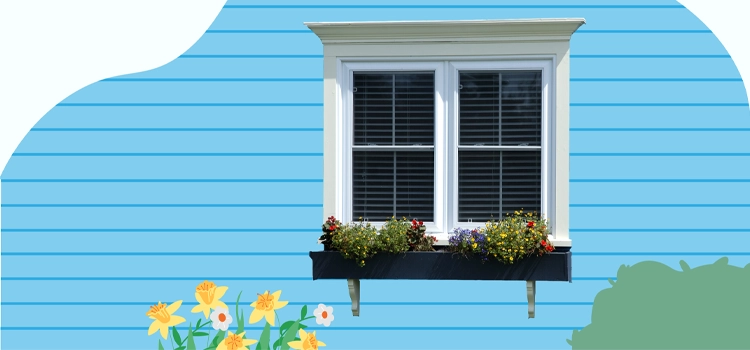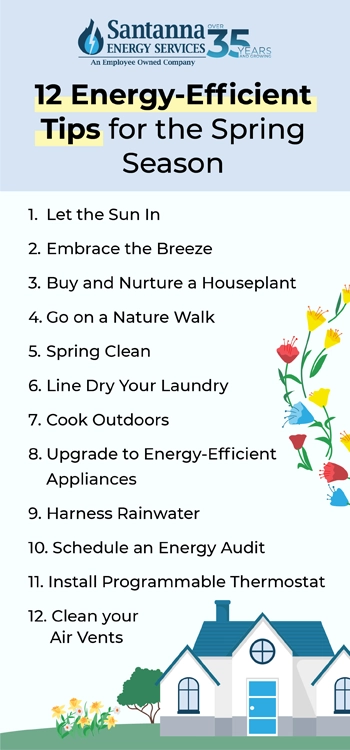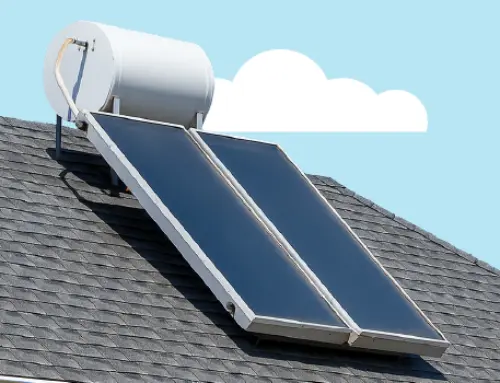Spring into Sustainability: 12 Energy-Efficient Tips for Spring
by Jenna Mendez
5.4 min read

Spring comes with a burst of energy and renewal in the air. It's the perfect time to embrace sustainability and energy efficiency in our daily lives by trying something new and getting our homes off to a fresh start.
Whether you're looking to be more eco-friendly in the season or simply looking to save some money on your energy bills, here are 12 spring-inspired tips to help you spring into sustainability:

1. Let the sunshine in
Why not let the sun shine throughout your home? Open up those curtains and let the natural light flood your home. Not only will this brighten up your space, but it will also reduce your reliance on artificial lighting.
According to Energy.gov, about 76% of sunlight that falls on standard double-pane windows enters to become heat. So not only will you be letting in natural sunlight, but this heat can also warm your home too! Reducing your need to use your heating system on the regular.
2. Embrace the breeze
Instead of cranking up your fans and using electricity, take advantage of the gentle spring breeze. Open your windows and let the fresh air circulate throughout your home, cooling it down naturally.
According to the University of Illinois, average spring highs range from 57°F (north) to 67°F (south), while average lows range from 36°F (north) to 48°F (south). Making springtime pleasant for open windows.
3. Buy and nurture a houseplant
Buying and nurturing a houseplant is a wonderful energy-efficient tip that brings a breath of fresh air into your home in more ways than one. Not only do houseplants enhance indoor air quality by absorbing carbon dioxide and releasing oxygen, but they also act as natural air purifiers, removing harmful toxins from the air.
Additionally, caring for houseplants can be a rewarding and mindful activity, fostering a deeper connection with nature and reducing stress levels.
4. Go on a nature walk
By stepping outside and immersing oneself in nature's beauty, individuals reduce their reliance on energy-consuming activities at home. Whether it's a stroll through a local park, a hike along forest trails, venturing into nature requires minimal energy consumption compared to indoor activities. Plus, the physical activity involved in walking provides an eco-friendly alternative to driving or using other forms of transportation.
5. Spring clean
As we embark on decluttering, dusting, and organizing our homes, we inadvertently streamline our living environment, making it more efficient and energy-conscious. Clutter interferes with the efficient operation of your heating system. By removing unnecessary items and optimizing storage, we create a more functional and energy efficient space.
Additionally, cleaning appliances and HVAC systems as part of the spring cleaning process ensures they operate at peak efficiency, reducing energy waste. For more energy efficient spring cleaning tips, visit our link!
6. Line-dry your laundry
If you're able to, and the weather is right, try out line drying your laundry! By harnessing the power of the sun and wind to dry your clothes naturally, you eliminate the need for electric or gas-powered dryers, significantly reducing energy consumption.
Not only does line drying save money on utility bills, but it also helps extend the lifespan of your clothing from wear and tear. Plus, who doesn't love the smell of sun-kissed clothing!
7. Cook outdoors
Whether you're firing up the grill for a backyard barbecue or preparing meals on a portable camping stove, cooking outdoors eliminates the need for traditional kitchen appliances like stoves and ovens. By harnessing the power of propane, charcoal, or wood, outdoor cooking reduces reliance on electricity or gas, resulting in energy efficiency.
8. Upgrade to energy-efficient appliances
According to Energy News Network, replacing outdated appliances can translate to 30% in energy savings.
By replacing older, inefficient appliances with ENERGY STAR-rated models, you can significantly reduce your energy consumption and utility bills. These modern appliances are designed to maximize efficiency while minimizing energy waste, using advanced technologies such as improved insulation, variable speed motors, and enhanced control systems.
For more about energy efficient tech, visit our article here!
9. Harness rainwater
By capturing rainwater from your roof or other surfaces and storing it in a rain barrel or cistern, you can reduce reliance on treated municipal water for tasks such as watering plants, washing vehicles, or even flushing toilets. This not only conserves precious drinking water but also reduces the energy required for water treatment and distribution.
10. Schedule an energy audit
During an energy audit, a trained professional assesses your home's energy efficiency by inspecting various components such as insulation, windows, doors, heating and cooling systems, and appliances. By pinpointing areas of energy loss or inefficiency, homeowners can make targeted improvements that result in significant energy savings.
Did you know you can perform your own DIY energy audit? It's true! To learn how to do just this, follow our guide here!
11. Install a programmable thermostat
With a programmable thermostat, you can automatically adjust the temperature settings based on your schedule, ensuring that your home is heated or cooled only when necessary. This eliminates energy waste by avoiding excessive heating or cooling when you're away or asleep.
Additionally, programmable thermostats often offer advanced features such as zoning capabilities, humidity control, and Wi-Fi connectivity, allowing for precise temperature management and remote access from your smartphone or computer.
12. Clean your air vents
Over time, dust, dirt, and debris can accumulate in your air vents, obstructing airflow and causing your HVAC system to work harder to maintain desired temperatures. By regularly cleaning your air vents and replacing filters, you can improve airflow efficiency, reduce strain on your HVAC system, and lower energy consumption.
This not only helps extend the lifespan of your HVAC system but also enhances indoor air quality by minimizing the circulation of airborne pollutants.
Embracing energy-efficient practices is not only beneficial for your home but also plays a crucial role in preserving our planet's resources for future generations. By implementing simple tips, you can look forward to a more efficient spring!
Santanna Energy Services is a supplier of renewable energy solutions in the United States, providing services to Illinois, Indiana, Pennsylvania, Michigan, and Ohio. We provide a wide range of energy services and products to meet the needs of both residential and small business customers. Our mission is to provide innovative and cost-effective energy solutions that will help our customers achieve their energy goals. With over 35 years of experience, we are committed to creating life-long relationships by providing quality service to customers, communities, and employees.
Jenna Mendez is a Midwest native with lifelong roots in Illinois and time spent in Ohio during college, giving her a deep understanding of the Midwest region’s people, climate, and energy needs. She brings firsthand experience and local insight to topics that matter to Midwest homeowners, especially energy efficiency, sustainability, and home living. Jenna specializes in writing about eco-friendly living, all things Midwest, renewable energy, and practical ways to reduce energy costs. Jenna brings a trusted, and local hometown voice to every article she writes, helping readers live well, and sustainably, right where they are.







